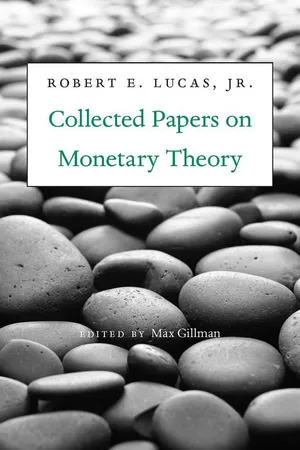Economics
Asset Market Equilibrium
Asset market equilibrium refers to the point at which the demand for and supply of financial assets, such as stocks and bonds, are in balance. At this equilibrium, the price of the assets reflects all available information and there is no incentive for investors to change their portfolios. This concept is crucial for understanding the pricing and allocation of financial assets in the economy.
Written by Perlego with AI-assistance
Related key terms
3 Key excerpts on "Asset Market Equilibrium"
- eBook - ePub
Investors and Markets
Portfolio Choices, Asset Prices, and Investment Advice
- William Sharpe(Author)
- 2011(Publication Date)
- Princeton University Press(Publisher)
Despite this completely valid observation, we need to understand the properties of a condition of equilibrium in financial markets, because markets will usually be headed toward such a position. And the more efficient the financial system, the smaller will be the discrepancies between market conditions and those of full equilibrium. Moreover, we will see that for many purposes the most important aspects of equilibrium for portfolio choice concern the levels of broad market indices, overall consumption, and other macroeconomic variables, which are likely to be closest to their equilibrium levels.Understanding the nature of a financial market in equilibrium is a crucial step toward understanding real financial markets. The goal of this book is to explore the relationships between investors' characteristics and investment opportunities and the key aspects of the situation that would be obtained if trading continued until equilibrium were reached.2.2. Determinants and ResultsEconomics is a social science, dealing with the behavior of individuals and the results of their interactions where money is concerned. When trying to understand equilibrium relationships the focus is descriptive, concentrating on what actually happens. But much of financial economics is prescriptive, attempting to help people make better financial decisions. Such decisions involve buying and selling financial assets at prices determined in markets. Good financial decisions require an understanding of the forces that determine such prices. More specifically, optimal portfolio choice requires an understanding of equilibrium.Figure 2-1 provides a simplified version of the operation of an exchange economy with two investors. Production is taken as given, with productive outputs represented by a set of securities. Individuals start with initial security portfolios, then trade securities in financial markets until no further voluntary trades can be made. When this point is reached, each person has a final security portfolio. The terms on which trades were made or, in some circumstances, the terms on which additional trades might be made, constitute security prices (more broadly, asset prices). - eBook - ePub
- Robert E. Lucas, Jr., Robert E Lucas, Max Gillman(Authors)
- 2012(Publication Date)
- Harvard University Press(Publisher)
2Asset Prices in an Exchange Economy
1. Introduction1This paper is a theoretical examination of the stochastic behavior of equilibrium asset prices in a one-good, pure exchange economy with identical consumers. The single good in this economy is (costlessly) produced in a number of different productive units; an asset is a claim to all or part of the output of one of these units. Productivity in each unit fluctuates stochastically through time, so that equilibrium asset prices will fluctuate as well. Our objective will be to understand the relationship between these exogenously determined productivity changes and market determined movements in asset prices.Most of our attention will be focused on the derivation and application of a functional equation in the vector of equilibrium asset prices, which is solved for price as a function of the physical state of the economy. This equation is a generalization of the Martingale property of stochastic price sequences, which serves in practice as the defining characteristic of market “efficiency,” as that term is used by Fama [7] and others. The model thus serves as a simple context for examining the conditions under which a price series’ failure to possess the Martingale property can be viewed as evidence of non-competitive or “irrational” behavior.The analysis is conducted under the assumption that, in Fama’s terms, prices “fully reflect all available information,” an hypothesis which Muth [13] had earlier termed “rationality of expectations.” As Muth made clear, this hypothesis (like utility maximization) is not “behavioral”: it does not describe the way agents think about their environment, how they learn, process information, and so forth. It is rather a property likely to be (approximately) possessed by the outcome - eBook - ePub
Macroeconomic Theory
A Dynamic General Equilibrium Approach - Second Edition
- Michael Wickens(Author)
- 2012(Publication Date)
- Princeton University Press(Publisher)
Crudely put, an arbitrage portfolio gives the investor something for nothing. Such opportunities are therefore rare. The financial market, seeing the existence of an arbitrage opportunity, would compete for the assets, thereby raising their price and eliminating the arbitrage opportunity. It is therefore common in the theory of asset pricing to assume that arbitrage opportunities do not exist and to impose this as a restriction. The implication is that if a market is efficient, then it is pricing assets correctly and quickly eliminates arbitrage opportunities.11.4.2 Market Efficiency
A market is said to be efficient if there are no unexploited arbitrage opportunities. This requires that all new information is instantly included in market prices. This is an exacting standard. In practice, fully and correctly reflecting all relevant information so that new information, or new ways of processing this information, have no effect on an asset or any other price is almost impossible to achieve. In principle, the concept should be extended even further to become a criterion of general equilibrium.The return on an asset may be written aswhere Pt is the price of the asset at the start of period t and Xt+1is its value or payoff at the start of period t + 1. For any risky asset i with return ri,t+1the absence of arbitrage opportunities implies that(11.8) Etri, t+= rft+ ρit,where rft, the return on the risk-free asset, is known with certainty at the start of period t, and ρitis the risk premium for the ith asset, which is also known at the start of period t.Equation (11.8) shows that asset pricing consists of pricing one asset relative to another, namely, the risk-free rate, then adding the risk premium. Traditional finance commonly does this by relating the risk premium to a set of factors determined from the past behavior of asset prices. An example is the use of affine factor models to determine the prices of bonds with different times to maturity, i.e., the term structure of interest rates (see chapter 12
Learn about this page
Index pages curate the most relevant extracts from our library of academic textbooks. They’ve been created using an in-house natural language model (NLM), each adding context and meaning to key research topics.


